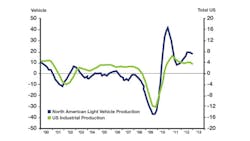Make Your Move: Consumer Spending Keeps Auto Industry on Growth Track
Navigating the twists and turns of the economy during 2012 certainly was unsettling to businesses. Election year detours, political roadblocks and fears of a fiscal cliff cropped up along the way, and the path for business leaders to follow was anything but clearly marked. However, our leading indicators have remained reliable and steadfast through all the noise, and they are showing us that the first half of 2013 will provide opportunities for growth before you'll need to prepare for slowing activity in the latter half of the year and then a mild recession in 2014.
For the auto industry, the health of the consumer is of utmost importance. The most recent numbers show annualized retail sales (excluding autos) at a record high $2.1 trillion, up 2.7% over last year. That number falls in line with our forecasted expectations for the year. With employment rising and interest rates remaining near record lows, the economic environment is currently favorable for enough consumer spending to keep the economy on a positive footing through the near term.
This positive economic activity has translated into increased auto sales. Annual light vehicle retail sales are currently around 14.4 million units for 2012, a gain of 13.4% over the same period last year. Annual sales for the Big Three makers -- Ford (IW 500/6), Chrysler, and General Motors (IW 500/4) -- have risen as well to 6.4 million units, but the pace of their growth has begun to slow. Honda (IW 1000/30) and Toyota (IW 1000/8), however, continue to see expanding activity, with sales now 19.1% and 25.7% above last year, respectively.
Manufacturers have responded to the increased activity over the past year by ramping up production. Total North America light vehicle production is over 15 million units on an annual basis, 19% higher than 2011. Light vehicle production by the Big Three has risen 9.7% above last year, but the rate of growth is beginning to wane. Within the Big Three, passenger car production has had the best performance (15% annual growth) while light truck production has risen 7.3% above last year's level, indicating that growth opportunities will vary by platform.
From an international view, activity in the auto industry is still moving ahead at a healthy clip. Annual Canadian auto production of light vehicles is 18.5% ahead of the same time last year, but a recent move by GM to shift production in one of its facilities from Ontario to Michigan has become a major source of concern for the Canadian auto industry.
South of the border, Mexican light vehicle production is seeing continued gains, with manufacturing activity 12.9% above last year's level, and there is no sign of near-term deceleration in the rate of growth. Mexico's low labor costs and strategic location to major markets has propelled it to the position of fourth largest exporter of automobiles in the world in a relatively short time. Continued economic difficulties in Europe and Asia could further strengthen Mexico's growing dominance in this sector.
Regarding the new year, there are no signs in the leading indicators of an immediate U.S. recession. China and Europe have managed to patch together enough stimulus measures and bailout funds to keep the wheels from falling off the global economy. However, we expect to see a slowdown the latter half of 2013 as inflationary and taxation pressures begin to weigh down the U.S. consumer. Stricter banking regulations are also slated to take effect by 2014, tightening credit for the average consumer.
These fiscal and regulatory changes translate into less disposable income for the American consumer and turn the mild growth of 2013 into a mild recession in 2014. For light vehicle manufacturers in North America this translates into a 2013 that ends roughly even with 2012. 2014 will provide more of a challenge as we expect production activity to decline by about 6% from 2013. Look to take advantage of near-term opportunities but begin to take on the challenges coming in 2014. 9
For more economic insights from ITR economics, check out the Mave Your Move Blog.


